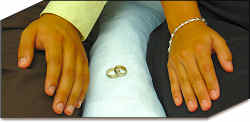 The National Runaway Switchboard reports that between 1.6 and 2.8 million youth run away each year. It also reports that there has been “a significant increase in the number of crisis calls identifying abuse or neglect as a reason for the call, with abuse calls up 33 percent and neglect calls up 54 percent between 2005-2008″ (National Runaway Switchboard Crisis Caller Trends, 2009, p. 2).
The National Runaway Switchboard reports that between 1.6 and 2.8 million youth run away each year. It also reports that there has been “a significant increase in the number of crisis calls identifying abuse or neglect as a reason for the call, with abuse calls up 33 percent and neglect calls up 54 percent between 2005-2008″ (National Runaway Switchboard Crisis Caller Trends, 2009, p. 2).
Youth in out-of-home care often choose conduct that does not ensure their own safety. They elope from foster homes, group homes, or other residential settings at an unknown rate. When children are known risks for eloping a court may find that it is the legal duty of the caregiver to take all prudent means to take appropriate preventative measures.
Instinctively, we are aware of the links between youths running away in general and youths eloping from out-of-home care. Social science research has made significant progress in describing runaway youth in general (Martinez, 2006; Sanchez, Waller, & Greene, 2006), but has made minimal inroads in accurately describing the phenomenon of youth eloping from out-of-home care. Similarly, while federal laws and conventions exist to address runaways and missing children, scant legislative attention has been paid … Read More... “Caregiver Liability: When Kids Run from Foster Care”


 I am pleased that Donna Ferber, a psychotherapist and a frequent contributor to the Ohio Family Law Blog has agreed to co-author this article with me! Our goal is to present both the legal and emotional perspectives of a trend that we are seeing in our professional practices: long term marriages ending by divorce when the wife has come to the conclusion that she has just “had enough” and that the husband is seemingly caught “blindsided” by the situation. The intent of the article is not a male versus female point and counterpoint, but rather a collaborative discourse that can provide insight into the complexity of the issues.
I am pleased that Donna Ferber, a psychotherapist and a frequent contributor to the Ohio Family Law Blog has agreed to co-author this article with me! Our goal is to present both the legal and emotional perspectives of a trend that we are seeing in our professional practices: long term marriages ending by divorce when the wife has come to the conclusion that she has just “had enough” and that the husband is seemingly caught “blindsided” by the situation. The intent of the article is not a male versus female point and counterpoint, but rather a collaborative discourse that can provide insight into the complexity of the issues. In a recent analysis of census data, the Pew Research Center found that the institution of marriage has undergone significant changes in recent decades as women have outpaced men in education and earnings growth. The study examined American’s 30 to 44 years old, a stage of life when typical adults have completed their education, have gone to work and gotten married. “Men now are increasingly likely to marry wives with more education and income than they have, and the reverse is true for women,” said Paul Fucito, spokesman for the Pew Center. “In recent decades, with the rise of well-paid working wives, the economic gains of marriage have been a greater benefit for men.” Clearly, these unequal gains have been accompanied by gender role reversals in both the spousal characteristics and the economic benefits of marriage.
In a recent analysis of census data, the Pew Research Center found that the institution of marriage has undergone significant changes in recent decades as women have outpaced men in education and earnings growth. The study examined American’s 30 to 44 years old, a stage of life when typical adults have completed their education, have gone to work and gotten married. “Men now are increasingly likely to marry wives with more education and income than they have, and the reverse is true for women,” said Paul Fucito, spokesman for the Pew Center. “In recent decades, with the rise of well-paid working wives, the economic gains of marriage have been a greater benefit for men.” Clearly, these unequal gains have been accompanied by gender role reversals in both the spousal characteristics and the economic benefits of marriage. A large body of research overwhelmingly suggests children do best when they have both a mother and a father involved in their lives. Specifically, children whose fathers participate in raising them do better in school, are less likely to get into trouble with the law, and are more likely to be better parents themselves. While more fathers are being awarded legal custody of their children, the statistics seem to indicate that the majority (between 75 and 85 percent) are awarded to mothers. Today, nearly 20 million children live in a home without a father (2002 U.S. Bureau of the Census). Recent Census Bureau child-custody statistics indicate that nearly 40% of non-custodial fathers have no access or visitation rights whatsoever with their children. A very troubling statistic, indeed! Of those that do have visitation rights, what percentage are actually seeing their children regularly? The statistics in the studies vary greatly. But it seems clear that frequently the amount of contact the children have with their fathers diminishes over time. A recent study published in the Journal of Marriage and Family finds that children born outside of marriage are less likely to be visited by their father when the mother is involved in …
A large body of research overwhelmingly suggests children do best when they have both a mother and a father involved in their lives. Specifically, children whose fathers participate in raising them do better in school, are less likely to get into trouble with the law, and are more likely to be better parents themselves. While more fathers are being awarded legal custody of their children, the statistics seem to indicate that the majority (between 75 and 85 percent) are awarded to mothers. Today, nearly 20 million children live in a home without a father (2002 U.S. Bureau of the Census). Recent Census Bureau child-custody statistics indicate that nearly 40% of non-custodial fathers have no access or visitation rights whatsoever with their children. A very troubling statistic, indeed! Of those that do have visitation rights, what percentage are actually seeing their children regularly? The statistics in the studies vary greatly. But it seems clear that frequently the amount of contact the children have with their fathers diminishes over time. A recent study published in the Journal of Marriage and Family finds that children born outside of marriage are less likely to be visited by their father when the mother is involved in …  The Pentagon reported the divorce rate among military members increased again in the past year and is now a full percentage point higher than it was around the time of the September 11, 2001, attacks. According to their figures, the divorce rate of about 3.6 percent for fiscal year 2009 increased from the reported 2001 rate of 2.6 percent. Women in uniform continued to have a much higher divorce rate than their male counterparts – 7.7% in 2009 compared with only 3% for men. Air Force Maj. April Cunningham, a Defense Department spokeswoman, said the latest year-to-year change was relatively small because the services have made available programs focused on strengthening and enriching family bonds among couples. “We believe these programs are instrumental in mitigating the stresses deployment places on marriages,” said Cunningham.
The Pentagon reported the divorce rate among military members increased again in the past year and is now a full percentage point higher than it was around the time of the September 11, 2001, attacks. According to their figures, the divorce rate of about 3.6 percent for fiscal year 2009 increased from the reported 2001 rate of 2.6 percent. Women in uniform continued to have a much higher divorce rate than their male counterparts – 7.7% in 2009 compared with only 3% for men. Air Force Maj. April Cunningham, a Defense Department spokeswoman, said the latest year-to-year change was relatively small because the services have made available programs focused on strengthening and enriching family bonds among couples. “We believe these programs are instrumental in mitigating the stresses deployment places on marriages,” said Cunningham. According to figures from the U.S. Census Bureau, there are 2.1 million adopted children and 4.4 million stepchildren of householders as estimated from the Census 2000 sample. Together, these children represented approximately 8 percent of the 84 million sons and daughters of householders in 2000.
According to figures from the U.S. Census Bureau, there are 2.1 million adopted children and 4.4 million stepchildren of householders as estimated from the Census 2000 sample. Together, these children represented approximately 8 percent of the 84 million sons and daughters of householders in 2000. I came across an interesting survey last month in the Gordon Poll Youth Survey published by the Wilmington Institute Network. Dr. Robert Gordon is the founder and director of the Wilmington Institute of Trial and Settlement Sciences. He is a past president of the Texas Psychological Association and is author of “On the Witness Stand.” He is both a clinical psychologist and a lawyer. The work of Dr. Gordon and the institute team has been featured on the MacNeil-Lehrer News Hour, ABC, Nightline, CNN, Fox News, Larry King Live, Good Morning America and USA Today.
I came across an interesting survey last month in the Gordon Poll Youth Survey published by the Wilmington Institute Network. Dr. Robert Gordon is the founder and director of the Wilmington Institute of Trial and Settlement Sciences. He is a past president of the Texas Psychological Association and is author of “On the Witness Stand.” He is both a clinical psychologist and a lawyer. The work of Dr. Gordon and the institute team has been featured on the MacNeil-Lehrer News Hour, ABC, Nightline, CNN, Fox News, Larry King Live, Good Morning America and USA Today.![[bar.gif]](https://www.hcmmlaw.com/blog/wp-content/themes/greenline-10/img/1b.gif) 40.22%
40.22%